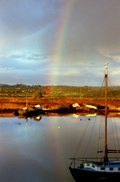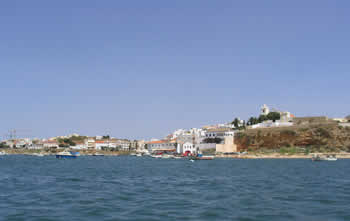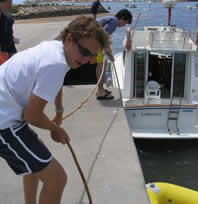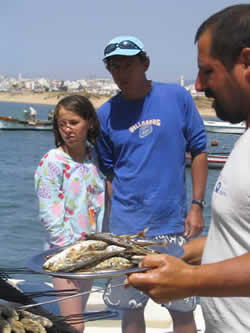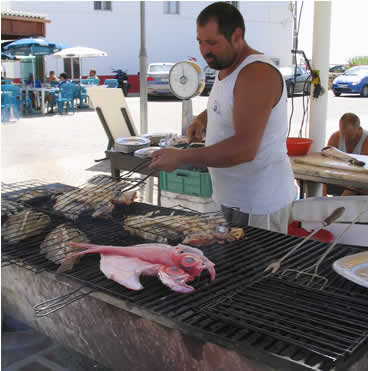
Sueste, the best fish restaurant in the world
Ferragudo, Algarve, Portugal August 21, 2004 The passage down the coast from Vilalara to the entrance to the Arade estuary is not far — maybe 10 or 15 nautical miles or so — but it is a gorgeous one which always helps to work up an immense appetite.
The red sandstone cliffs of the Algarve, carved by wind and time into intricate inlets and caves and arches, and with its unspoiled golden sandy beaches, makes this one of the most beautiful stretches of coastline that you will find anywhere in the world. We pass the tiny cliff-perched white fisherman’s church, A Senhora da Rocha, and head for the lighthouse at Carvoeiro. Once around this significant headland, we anchor off and plunge overboard for a swim. Continuing further down the coast, the striped port and starboard lights that mark the entrance to the Arade soon come into view, with the larger town of Lagos visible further down the coast to the west. We turn into the estuary and make out way upriver to Ferragudo.
The approach to Ferragudo
Salty from the sea, with that powdery white layer on our skin that is the crusty feel of summer, we nose the boat on to the quay, make fast, and swagger up the steps, happy once more to have reached the best fish restaurant in the world (or at least in our world): Sueste.
Guy and Toby make fast our yellow RIB
There must be literally hundreds, no, even thousands of restaurants offering the fresh and outstanding fish of the Algarve, simply cooked over charcoal. Why do we consider Sueste head and shoulders above everywhere else that we’ve tried over the past quarter of a century? One principal reason, I’m certain, is that the fish, landed on the quay and brought straight into the restaurant direct from the boats, is always big. Apart from sardines (which here are always beautifully fat, if by nature small), you don’t come to Sueste to mess about with little dinky fish. Even if you are only two, and better still if you are a larger group, there will always be a big fish just the right size for you and your party. And if, while in many cases, small may be beautiful, in our experience with fish, larger almost always means better. The flesh of a large fish is thicker and comes off the bone easier, there is far less waste of bones, skin and head in proportion to flesh, and if cooked well and just to the precise degree of doneness, a big fish is always infinitely juicier and more delicious. At Sueste, this is what you get: big fish, straight off the boats, whatever’s just been caught, grilled to absolute perfection.
Cold Sagres beer in hand, I always immediately make for the fish cabinet or to the quayside grill to seek advice from the helpful and friendly waiters or from the grill cook. The selection of fish is always varied and plentiful: there is most usually available large robalo – sea bass – as well as various types of bream, such as our favourite dourada – gilt head, the finest of all breams. Sogliola - Dover sole - is another always popular fish. We’ve enjoyed a mighty tasty meal of anchova, a large bluefish-type not remotely like the far smaller similar-sounding anchovy, its oily dark as delicious as its succulent white flesh. Sometimes we just feel like a simple fisherman’s feast of sardinhas or the slightly larger (and still incredibly inexpensive) carapaus. Today the waiter suggests imperador, a rather odd looking red fish with massive, popping eyes. ‘Really, it’s one of the best fish at this time of year, thick, soft and very juicy. And not too expensive.’ (Fish is sold by the kilogram and price varies depending on variety as well as on what’s been landed in quantity that day.)
Before ordering, Bella and Marc cast an eye over the fish —
don't those sardines look delicious!Our meal starts off with a basket or two of dense, chewy sourdough bread, delicious and virtually a meal in itself; a plate of olives; some packets of strong sardine paste (the taste of Portugal); some vividly orange carrots, boiled and dressed in olive oil and copious amounts of raw garlic; a tub or two of some fresh cheese. To drink, I order a bottle of Quinta da Aveleda or Muralhas vinho verde, light, bone dry, incredibly quenching in the midday heat. We can’t resist ordering a dose, that is a small platter of ameijôas to nibble on while we wait for the fish, the succulent and prized clams of the Algarve cooked simply in olive oil, garlic and chopped coentra (coriander), to be picked up on the shell and eaten with the fingers, the flavourful juices running down our chins and mopped up with that fabulous chewy bread.
Meanwhile, our chosen fish is carefully prepared. This is a specialist operation. One man’s job is simply to clean, gut and scale the fish; another looks after the charcoal fire. The grill cook, imperious in a sleeveless vest and swimming trunks, and certainly one of the best grill chefs I've encountered anywhere, expertly splits the fish and butterflies it out, paints it with oil, sprinkles with coarse rock salt, then cooks it carefully over the hot coals. The fish is placed on a simple metal rack that he turns constantly, brushing the fish from time to time with more oil, moving it to a cooler or hotter part of the grill, never giving it less than his fullest attention even for the briefest moment (no matter how many fish are on the grill at any given time). These are the keys to successful grilling: constant vigilance, an intimate knowledge of the fire and the varying hot spots on the grill, and an intuitive sense of that precise moment when a fish is cooked but not yet overcooked.
The grill cook in action:
our imperador, butterflied, is cooked with skill and precisionOur imperador is indeed as exquisite as the waiter had promised, the flesh thick and softly textured, far more delicate than any bream, yet with a deep and delicious flavour of the sea. It is served with small potatoes in their skins, boiled in seawater, and a simple salad of lettuce, onions and big chunks of green-red tomatoes, dressed simply with good extra virgin olive oil from the Alentejo, a splash of vinegar. Kim is the expert at prising out every last morsel of fish off the skeleton, and we linger long over this fishy feast, enjoying finding those last little bits that taste even sweeter for being unexpected. The meaty cheeks are a particularly prized delicacy.
Guy and Bella finish off their midday repast with typical Portuguese sweets, perhaps pudim flan (crème caramel), or mousse do chocolate, or (Guy's favourite) arroz doce (rice pudding); we opt instead to finish with good strong bicas - Portuguese espresso, as good, nearly, as Italian.
Replete and utterly satisfied, we saunter over to the grill for a last look at what's going on, then jump down off the quay on to the boat (the tide having meanwhile come in), cast off, and chug slowly away. By now the prevailing sueste, after which the restaurant is of course named, has come up, and we can see white horses on the sea beyond the entry to Arade estuary. It may be a rather rough and wet return passage, and, once we've managed to moor the boat in the agitated sea offshore, it will be an even trickier and wetter row back through the surf to land the rubber dinghy on the beach. Getting soaked; feeling crusty and salty; wading through the surf; tasting the sea through every pore in our bodies: that's what it's really all about and we wouldn't want it any other way.
![]()
|Home| |QP New Media| |Kim's Gallery|
Copyright © Marc and Kim Millon 2004
![]()
